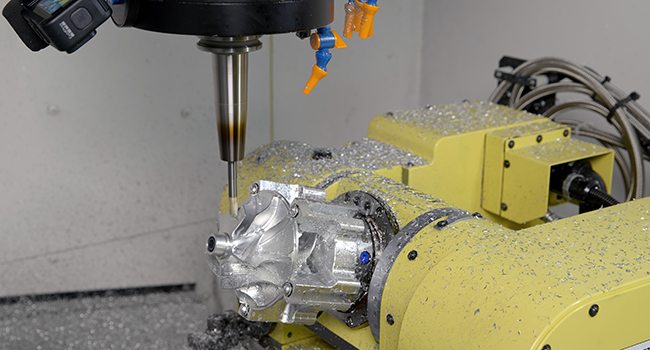Few techniques are more touted or more feared in the subtractive manufacturing industry as multiaxis machining. Sometimes it can seem like it’s best to leave multiaxis to the big players—international aerospace manufacturers and giant defense shops—because it seems like they’re the only ones equipped for it. But so many of the ideas that circulate about multiaxis machining are really myths. We are here to bust those myths and to help you decide whether or not multiaxis is for you.
Multiaxis Myth #1: I need a multiaxis machine to get started with multiaxis machining
If the immediate start-up costs to multiaxis machining are holding you back, there’s good news: you don’t need a multiaxis machine to get started. Positional 5-axis machining, more commonly called 3+2 machining, uses a traditional 3-axis milling center. It differs from true simultaneous 5-axis machining in that the cutting tool is locked into a specific angle on the two additional rotary axes. With 3+2 machining, your spindle can move closer to your workpiece, allowing you to use shorter, more rigid cutting tools. This provides some of the benefits of multiaxis machining – reduced cycle times, better surface finishes, increased accuracy, and fewer machine setups – without your ever needing to touch a multiaxis machine. Mastercam Mill comes equipped with 3+2 machining solutions
Multiaxis Myth #2: My shop doesn’t make crazy aerospace parts; we couldn’t benefit from something like multiaxis
While the aerospace industry is most notorious for taking advantage of multiaxis machining, the truth of the matter is that it’s harder to find a shop that can’t benefit from multiaxis than to find a shop that can. Multiaxis isn’t just for exceptionally complex parts with infinitesimal tolerances. One of the biggest benefits to using multiaxis machining is reducing setups. Especially in today’s job market, where shops are desperate to find skilled machinists, relying on machining styles that require four, five, or even more setups for certain parts is simply wasteful of employee time. Consider that every setup requires an employee to stop what they’re doing – or worse, stand by the machine and do nothing while it runs, waiting to set up again – and remove the part, re-fixture it, replace it, and start the machine again. Even if you ignore the fact that every time someone handles the part, they introduce opportunity for human error, the bottom line is that multiple setups are inefficient. If you want to take the next step towards automating your shop and even running parts lights-out, multiaxis might be for you.
Multiaxis Myth #3: There’s too much to learn to be profitable with multiaxis
There was a time when simple manual milling was daunting because it was more complex than anything most metalworkers had ever seen. That didn’t stop it from absolutely dominating the manufacturing industry. Like any new technology, multiaxis can be intimidating to jump into, but the consequence of ignoring it is being left in the dust by your competition. Luckily, it isn’t nearly as complicated as some make it out to be. While the toolpaths within the Mastercam Multiaxis product are intuitive and easy to learn, your local Reseller will have a wealth of knowledge that they are only too happy to share. Most Resellers can send sample files, come out to your shop for quick training, teach courses at their headquarters, and even troubleshoot specific problems over the phone or email. Want more? Check out Mastercam University or our partner camInstructor.
Multiaxis Myth #4: Multiaxis tooling and fixturing is too expensive
A common misconception is that you need special tools for multiaxis machining. The truth is the exact opposite: you can actually use tools that you couldn’t get away with in traditional machining, like much shorter tools. By rotating the part or the tool, you can get much closer to part features. As for multiaxis fixtures, they do tend to be more expensive, but multiaxis machining techniques allow you to reuse those fixtures again and again. Consider also that you will most often be machining parts in one setup instead of many, and the number of required fixtures decreases again. The result is that some – if not most – shops will actually save on tooling and fixturing costs with multiaxis.
Multiaxis Myth #5: Multiaxis machines are all 5-axis
While four is the minimum number of axes a machine must be able to move along in order to be considered a multiaxis machine, some multiaxis machining centers can operate on up to nine axes. Any time a machine moves on more than the traditional three linear axes (X, Y, and Z), they are using multiaxis technology. The most common is 5-axis machining, in which two of the three additional rotary axes (A, B, and C) are added to the traditional three linear axes. These rotary axes move around the linear axes, and give the machine more maneuverability. Machines that work on nine axes use the linear and rotary axes (X, Y, Z, A, B, and C) as well as additional axes (U, V, and W). There is no such thing as a standard 5-axis machine or standard multiaxis machine. They come in as many configurations as there are styles of machining.
This content was first published on the Mastercam website.

